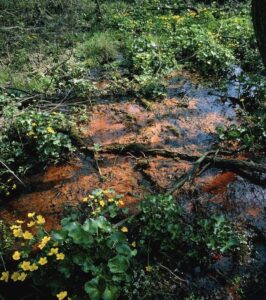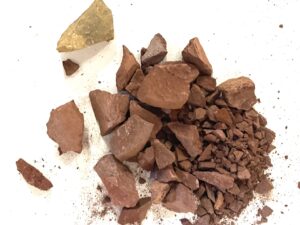Art Adventure • 7.24.2023 • Slime!
It’s been a busy couple of weeks: a natural pigment workshop at what used to be Harvard’s Fogg Museum and is now part of the Harvard Art Museums complex; an investigation into a surprising source of red ochre pigment; and the first alchemical experiment of this art adventure.
The workshop was presented by the very knowledgeable Julia Norton, an artist and color materials researcher who has traveled widely to explore natural sources of pigment, dyes, and inks, and to learn about traditional and indigenous methods of processing and using them, all the while considering issues of cultural appropriation, intellectual property rights, and her responsibilities as a researcher and educator. She started the session with a presentation chock full of facts and topics that I am eager to explore further. One of the most interesting was that JMW Turner encouraged a Belgian colourman to open a store in London in 1848, and L. Cornelissen & Son still exists, an exciting bit of information for me because I will be visiting London in October with my daughter. Then we used pigments she provided to make watercolor paint, a process that is embarrassingly easy and gives the lie to my assumption that making paint would be the main challenge I set for myself in my grant application. The real challenge is finding and processing the natural raw materials from which to make the paint.
And that gets us to slime.
Iron ochre slime accumulates in basements, drains, pipes, wells, sump pumps and on the surface of lakes and other bodies of water. It can be a major plumbing problem because it is almost impossible to completely eradicate the bacteria that makes the ochre.
Iron-eating bacteria (Leptothrix ochracea) live by oxidizing minerals dissolved from water, usually from ferrous iron, but sometimes also fr om manganese. This process creates a reddish-brown filamentous slime that can also form extensive mats on the surface of marshes, ponds and lakes (and then may be referred to as “lake goo”). It is thick, sticky and stinky.
om manganese. This process creates a reddish-brown filamentous slime that can also form extensive mats on the surface of marshes, ponds and lakes (and then may be referred to as “lake goo”). It is thick, sticky and stinky.
Researchers, working with a small chip of pigment from a pictograph panel at Boling Point on Babine Lake in British Columbia, have concluded that peoples of the Pacific Northwest developed a fire-based technology to extract red ochre pigment (or biogenic ironoxides) from the goo as early as 5,000 years ago. The scientists’ interest was in reconstructing the technological process that turned the orange-brown slime into a colorfast, thermostable bright red pigment. As a result of their experiments, they posit that the process used by this group of people involved harvesting the aquatic microbial iron mats, breaking them up, and subjecting the resulting material to a controlled open-hearth wood-fueled fire at 750 °C to 850 °C. Not much research has been conducted on the ancienthuman use of biogenic iron oxides so we don’t know if the people of Babine Lake invented this process independently or learned it from others; eventually we may learn how far back in history this process was known.
Fire was also the crucial e lement in the first alchemical process explored in this inquiry into natural pigments. My dear friend Joe Donnelly is a ceramicist and glass artist. He offered to use his glass kiln, which can reach temperatures up to 1600 °F, to calcine some of the yellow ochre Abby and I had found in Georgetown. I took a hammer to several chunks and was relieved to know that I could readily break it up into pebble-size chunks (though I’m going to borrow a sledgehammer for my next rock-crushing session). But nowhere could I find exact instructions about how to calcine the yellow ochre, so I made an educated guess based on my reading, and Joe agreed to heat the yellow ochre to 800 °F and hold it there for 30 minutes.
lement in the first alchemical process explored in this inquiry into natural pigments. My dear friend Joe Donnelly is a ceramicist and glass artist. He offered to use his glass kiln, which can reach temperatures up to 1600 °F, to calcine some of the yellow ochre Abby and I had found in Georgetown. I took a hammer to several chunks and was relieved to know that I could readily break it up into pebble-size chunks (though I’m going to borrow a sledgehammer for my next rock-crushing session). But nowhere could I find exact instructions about how to calcine the yellow ochre, so I made an educated guess based on my reading, and Joe agreed to heat the yellow ochre to 800 °F and hold it there for 30 minutes.
The results were just what I had hoped but had not dared expect! The yellow ochre darkened to a gorgeous reddish-brown very similar to the burnt siennas and burnt umbers that have composed an important part of my palette over the past 10 years. (Thi photo of the calcined ochre shows the original yellow in the upper left corner.)
So now I have three colors – the yellow ochres from Lexington and Georgetown, the red ochre we found in Georgetown, and the calcined yellow ochre that resembles burnt sienna!
With that wealth of resources in hand, I am going to skip the lake goo for now.